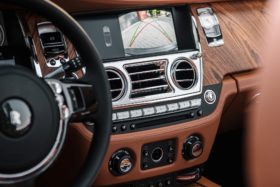Rear View Cameras on Cars: What You Need to Know

For many of us, we learned how to drive using cars that were equipped with nothing more than mirrors to help people see their blind spots. However, it’s not hard to see (no pun intended) where mirrors can fall short. When trying to back a car up using only a standard rear view mirror, your visibility is extremely limited. Even when a rear view mirror is adjusted correctly, it can’t help you see anything below the level of your rear window and an inability to see that space can potentially be dangerous.
In 2014, the NHTSA and US Department of Transportation ordered that backup cameras be standard features on all new cars, SUVs, and trucks weighing less than 10,000 pounds manufactured after May 1, 2018. The reason these cameras, which had been optional on cars for years before, were ordered to become standard was to prevent injuries and fatalities caused by backover accidents.
The Facts About Backover Accidents
Small children and animals can easily become the victims of backover accidents since they may be blocked from the view of a driver trying to back up using only a standard rear view mirror. In 2014, the NHTSA estimated that 267 deaths and 15,000 injuries were caused by backover car accidents each year, with 84 of those 267 deaths involving children under the age of 5. People over the age of 70 are another common victim of backover accidents, representing 70 of those 267 fatalities.
However, the IIHS notes that it’s difficult to know the full extent of backover accidents since they tend to most commonly occur in driveways and parking lots instead of public roads and many government databases only collect data on crashes that occur on public roads.
The Pros and Cons of Rear View Cameras on Cars
Blind spots with standard rear view mirrors can be very large and backup cameras are required to provide a clear view of the space 10-20 feet behind the vehicle, significantly reducing that blind spot. A rear view camera can also generally be helpful while trying to park, whether you’re attempting to parallel park or simply trying to see if you need to adjust your car’s placement in a perpendicular spot in a parking lot.
While rear view cameras can be very helpful in improving visibility in the area below a vehicle’s rear window, they aren’t a perfect solution. When these cameras are used together with a vehicle’s mirrors, some blind spots still exist. As is the case with many other modern vehicle features, some drivers may get a false sense of security from using a car’s rear view camera. They may try to back up using only the camera or not physically turn to look as they back up. People might also forget to look behind their car before getting in or be distracted while the car is in reverse. Rear view cameras still require drivers to be fully attentive and actively monitoring their surroundings.
Contact a Michigan Car Accident Lawyer
If you’ve been injured in a car accident, don’t hesitate to contact a car accident lawyer for help with your case. Insurance companies may want you to accept a settlement as quickly as possible, but it’s important to have someone on your side who can help make sure you get all of the care you need both today and in the future. At Goodwin & Scieszka, you’ll be able to talk to a lawyer experienced in handling all types of motor vehicle accident cases in the state of Michigan, including car accidents, truck accidents, and motorcycle accidents. Contact us today to find out how we can help with your case.
Image: Martin Katler / Unsplash






